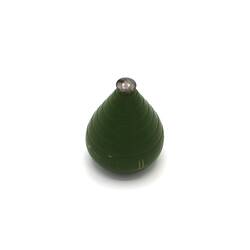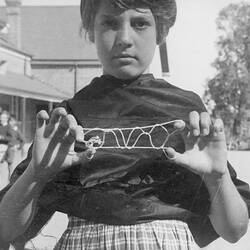Summary
Alternative Name(s): Peg Top
Used: circa 1930
Donated by B. Alexander, who played with these tops when she was about 15 years old, in the 1930s.
The Australian Children's Folklore Collection is unique in Australia, documenting contemporary children's folklore across Australia and in other countries reaching back to the 1870s. The Collection has a strong component of research material relating to Victoria.
Top-spinning is an ancient activity. Tops dated at 1200-1400BC were excavated in Egypt, and they are often mentioned in classical literature. They are found throughout the world and used by adults and children, in rituals as well as for games of skill. There are many different kinds of tops, and the way they are used depends on their size and shape. In Australia this top is called a peg top, or what is sometimes referred to as a 'boy's' top because peg tops were mostly used by boys. Girls usually used whipping tops. The top is spun by winding string around the body, and holding the end of the string while the top is thrown downwards. The string is jerked to start the top spinning. Australian children no longer use peg tops as a playground game, except in the context of historical activities.
Physical Description
Small wooden peg top, painted green, with a curved-headed metal tack in the point. Top has a curved top and a conical-shaped body with 6 shallow grooves around it. There are 4 square indentations and a small hole in the flat surface of the top. Acknowledgement: Australian Children's Folklore Collection, Museum Victoria.
More Information
-
Collection Names
-
Collecting Areas
-
Acquisition Information
Cultural Gifts Donation from Dr June Factor, 18 May 1999
-
Acknowledgement
Donated through the Australian Government's Cultural Gifts Program.
-
Date Used
-
Classification
-
Category
-
Discipline
-
Type of item
-
overall dimensions
4.5 cm (Length), 4.5 cm (Width), 6 cm (Height)
-
References
Gould, D.W.; The Top, Universal Toy, Enduring Pastime; Bailey Bros & Swinfen Ltd., Folkestone, England. 1975
-
Keywords
Children's Folklore, Children's Play, Toys, Woodworking, Making History - Australian Childrens Folklore



